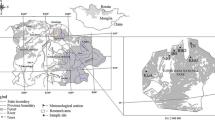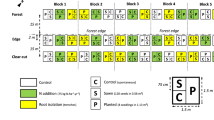Abstract
Since the natural regeneration of Scots pine forests is known to be difficult, the effects of canopy structure and environmental variables such as light on germination, seedling growth, and mortality need to be well understood. The knowledge on the relationships between canopy structure, environmental variables, and seedling growth have been helpful for forest managers to formulate silvicultural prescriptions that enhance seedling recruitment. In this study, the influences of stand basal area (BA) (m2 ha−1), leaf area index (LAI), light transmittance (LT), and height-to-crown base (HCB) on germination and seedling growth were explored in a naturally regenerated Scots pine forest in Kastamonu, Turkey. The number of germinants was observed following germination, and total root-collar diameter (RCD) and height of seedlings were monitored after five growing seasons following germination. BA, LAI, LT, and HCB were also examined to determine which variable has more influence on Scots pine seedlings. All variables (i.e., BA, LAI, LT, and HCB) had significant influence on the total seedling growth over a 5-year period. LT was the most significant predictor for total RCD growth and height growth of Scots pine seedlings. The data support the importance of light transmittance through the canopy, along with vertical canopy structure (i.e., HCB) when considering seedling development under a stand canopy.


Similar content being viewed by others
References
Akkemik, Ü., D'Arrigo, R., Cherubini, P., Köse, N., & Jacoby, G. C. (2008). Tree-ring reconstructions of precipitation and streamflow for north-western Turkey. International Journal of Climatology, 28(2), 173–183.
Anonymous. (2014). Orman Atlası. Ankara: Publications of General Directorate of Forestry 116 p.
Arnold, T. W. (2010). Uninformative parameters and model selection using Akaike’s information criterion. The Journal of Wildlife Management, 74(6), 1175–1178.
Assenac, G. (2000). Interactions between forest stands and microclimate: Ecophysiological aspects and consequences for silviculture. Annals of Forest Science, 57, 287–301.
Barbeito, I., Fortin, M. J., Montes, F., & Canellas, I. (2009). Response of pine natural regeneration to small-scale spatial variation in a managed Mediterranean mountain forest. Applied Vegetation Science, 12, 488–503.
Boydak, M., Ertaş, A., & Çalışkan, S. (2011). Eskişehir -Çatacık yöresi sarıçamlarında (Pinus sylvestris L.) tohum verimi. Journal of the Faculty of Forestry Istanbul University, 61(2), 17–37.
Brandeis, T. J., Newton, M., & Cole, E. (2001). A comparison of overstory density measures for describing understory conifer growth. Forest Ecology and Management, 152, 149–157.
Bréda, N., & Granier, A. (1996). Intra-and interannual variations of transpiration, leaf area index and radial growth of a sessile oak stand (Quercus petraea). Annales des Sciences Forestières, 53, 521–536.
Bring, J. (1994). How to standardize regression coefficients? Am Stat, 48(3), 209–213.
Brockway, D. G., & Lewis, C. E. (1997). Long-term effects of dormant-season prescribed fire on plant community diversity, structure and productivity in a longleaf pine wiregrass ecosystem. Forest Ecology and Management, 96, 167–183.
Calama, R., Manso, R., Barbeito, I., Madrigal, G., Garriga, E., Gordo, F. J., & Pardos, M. (2015). Do inter-specific differences in seed size determine natural regeneration traits in Pinus pinea and Pinus sylvestris? Applied Ecology and Environmental Research, 13(2), 387–404.
Carus, S. (2004). Increment and growth in timberline Scotch pine (Pinus sylvestris L.) stands at Ilgaz Mountain, Turkey. Pakistan Journal of Biological Sciences, 7(2), 212–218.
Castro, J., Zamora, R., Hódar, J. A., & Gómez, J. M. (2004). Seedling establishment of a boreal tree species (Pinus sylvestris) at its southernmost distribution limit: Consequences of being in a marginal Mediterranean habitat. Journal of Ecology, 92(2), 266–277.
Çolak, A. H., Tokcan, M., Rotherham, I. D., & Atici, E. (2009). The amount of coarse dead wood and associated decay rates in forest reserves and managed forests, northwest Turkey. Investigación Agraria: Sistemas y Recursos Forestales, 18(3), 350–359.
Collet, C., Lanter, O., & Pardos, M. (2001). Effects of canopy opening on height and diameter growth in naturally regenerated beech seedlings. Annals of Forest Science, 58, 127–134.
Egnell, G., & Leijon, B. (1999). Survival and growth of planted seedlings of Pinus sylvestris and Picea abies after different levels of biomass removal in clear-felling. Scandinavian Journal of Forest Research, 14(4), 303–311.
Ertugrul, M., Varol, T., & Özel, H. B. (2014). Climate changes in prospect for the West Black Sea Forests. Journal of Bartin Faculty of Forestry, 16(23), 35–43.
Fang, Z., & Bailey, R. L. (2001). Nonlinear mixed effects modeling for slash pine dominant height growth following intensive silvicultural treatments. Forest Science, 47(3), 287–300.
Gaudio, N., Balandier, P., Perret, S., & Ginisty, C. (2011). Growth of understorey Scots pine (Pinus sylvestris L.) saplings in response to light in mixed temperate forest. Forestry, 84(2), 187–195.
Geiger, E. L., Gotsch, S. G., Damasco, G., Haridasan, M., Franco, A. C., & Hoffmann, W. A. (2011). Distinct roles of savanna and forest tree species in regeneration under fire suppression in a Brazilian savanna. Journal of Vegetation Science, 22(2), 312–321.
Gerelbaatar, S., Baatarbileg, N., & Batsaikhan, G. (2015). Density and growth performance of Scots pine (Pinus sylvestris L.) understory saplings in logged forests of Tujiin Nars National Park in the Western Khentii Mountains, case study from northern Mongolia. Global Advanced. Research Journal of Agricultural Science, 4(1), 17–25.
Gingrich, S. F. (1967). Measuring and evaluating stocking and stand density in upland hardwood forests in the central states. Forest Science, 13, 38–53.
Haack, O. H. A. (1912). Uber die Keimung und Bewertung des Kiefernsamens nach Keimproben. Die Prüfung des Kiefernsamens, 44, 273–307.
Hille, M., & Den Ouden, J. (2004). Improved recruitment and early growth of Scots pine (Pinus sylvestris L.) seedlings after fire and soil scarification. European Journal of Forest Research, 123(3), 213–218.
Hox, J. J. (2002). Multilevel analysis: Techniques and applications. Mahwah, NJ: Lawrence Erlbaum Associates 392 p.
Hsu, F. H., Nelson, C. J., & Chow, W. S. (1984). A mathematical model to utilize the logistic function in germination and seedling growth. Journal of Experimental Botany, 35(11), 1629–1640.
Kara, F., Loewenstein, E. F., & Brockway, D. G. (2017). Effects of basal area on survival and growth of longleaf pine when practicing selection silviculture. Forest Systems, 26(1), 1–12.
Lhotka, J. M., & Loewenstein, E. F. (2008). Influence of canopy structure on the survival and growth of underplanted seedlings. New Forests, 35, 89–104.
Lundqvist, L., & Fridman, E. (1996). Influence of local stand basal area on density and growth of regeneration in uneven-aged Picea abies stands. Scandinavian Journal of Forest Research, 11, 364–369.
Mason, W. L., Edwards, C., & Hale, S. E. (2004). Survival and early seedling growth of conifers with different shade tolerance in a Sitka spruce spacing trial and relationship to understory light climate. Silva Fennica, 38(4), 357–370.
McDonald, J. H. (2014). Handbook of biological statistics (3rd ed.). Baltimore, Maryland: Sparky House Publishing 305 p.
Nilsson, M. C., & Zackrisson, O. (1992). Inhibition of Scots pine seedling establishment by Empetrum hermaphroditum. Journal of Chemical Ecology, 18(10), 1857–1870.
Noémie, G., Philippe, B., Sandrine, P., & Christian, G. (2011). Growth of understorey Scots pine (Pinus sylvestris L.) saplings in response to light in mixed temperate forest. Forestry, 84(2), 187–195.
Nyman, B. (1963). Studies on the germination in seeds of Scots pine (Pinus silvestris L.) with special reference to the light factor (No. 2). Stockholm: Studia Forestalia Suecica 163 p.
Odabaşı, T., Calışkan, A., & Bozkuş, H. F. (2004). Silvikültür Tekniği. Istanbul: Istanbul University Publications. Publication no: 4459 314 p.
Öner, N. (2003). Height development relations between naturally and artificially raised Scots pine (Pinus sylvestris L.) in forests of Kapaklı (Beypazarı) forest subdistrict. Süleyman Demirel Üniversitesi Orman Fakültesi Dergisi, 1, 153–166.
Pardos, M., Montes, F., Aranda, I., & Cañellas, I. (2007). Influence of environmental conditions on germinant survival and diversity of Scots pine (Pinus sylvestris L.) in central Spain. European Journal of Forest Research, 126(1), 37–47.
R Development Core Team. (2010). R: A language and environment for statistical computing. Vienna: R Foundation for Statistical Computing.
Ricard, J. P., Messier, C., Delagrande, S., & Beaudet, M. (2003). Do understorey respond both to light and below-ground competition? A field experiment in a north-eastern American hardwood forest and a literature review. Annals of Forest Science, 60, 749–756.
Richardson, D. M. (1998). Ecology and biogeography of Pinus. Cambridge: Cambridge University Press 546 p.
Rojo, A., & Montero, G. (1996). El pino silvestre en la Sierra de Guadarrama. Madrid, ES: Ministerio de Agricultura, Alimentacio´ n y Pesca 293 p.
Snipes, M., & Taylor, D. C. (2014). Model selection and Akaike information criteria: An example from wine ratings and prices. Wine Economics and Policy, 3(1), 3–9.
Timilsina, N., & Staudhammer, C. L. (2012). Individual tree mortality model for slash pine in Florida: A mixed modeling approach. Southern Journal of Applied Forestry, 36(4), 211–219.
Vales, D. J., & Bunnell, F. L. (1988). Relationships between transmission of solar radiation and coniferous forest stand characteristics. Agricultural and Forest Meteorology, 43, 201–223.
Author information
Authors and Affiliations
Corresponding author
Additional information
Publisher’s Note
Springer Nature remains neutral with regard to jurisdictional claims in published maps and institutional affiliations.
Rights and permissions
About this article
Cite this article
Kara, F., Topaçoğlu, O. Influence of stand density and canopy structure on the germination and growth of Scots pine (Pinus sylvestris L.) seedlings. Environ Monit Assess 190, 749 (2018). https://doi.org/10.1007/s10661-018-7129-x
Received:
Accepted:
Published:
DOI: https://doi.org/10.1007/s10661-018-7129-x




